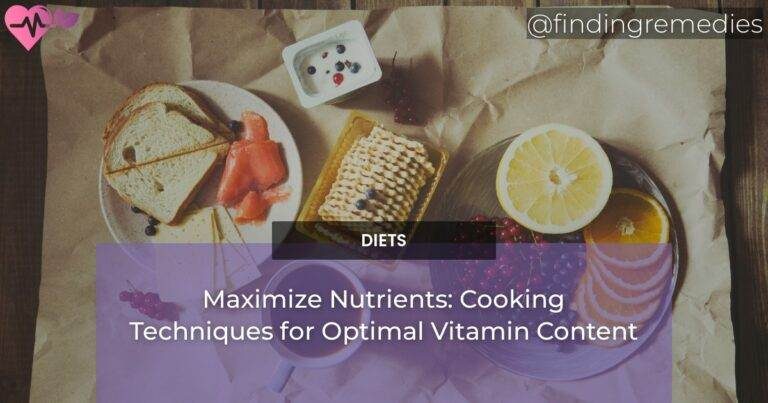Vitamins play a crucial role in our overall health and well-being, as they are essential for various bodily functions. They are essential nutrients that our bodies need in small amounts to function properly. While it is common knowledge that we can obtain vitamins through the foods we eat, what many people may not be aware of is that the way we prepare and cook our food can affect the vitamin content. This article will delve into the topic of cooking and its impact on vitamin content, exploring the changes in nutrient content during cooking and the different cooking methods and their effects on vitamin preservation. By understanding how cooking affects vitamin content, we can make informed choices about our food preparation techniques to ensure we are getting the most out of the vitamins in our diet.
Changes in Nutrient Content during Cooking
Effects of Heat on Vitamin Content
Heat is one of the primary factors that can impact the vitamin content of cooked foods. While heat is necessary for cooking, excessive heat can lead to the degradation of vitamins. Different vitamins have varying levels of susceptibility to heat, with some being more heat-sensitive than others.
Water-Soluble Vitamins and their Susceptibility to Heat
Water-soluble vitamins, such as vitamin C and B vitamins, are particularly vulnerable to heat. These vitamins dissolve in water and are easily leached out during cooking, especially when foods are boiled or soaked for a long time. The longer the cooking time and the higher the heat, the more significant the loss of water-soluble vitamins.
ALSO READ
Fat-Soluble Vitamins and their Susceptibility to Heat
Fat-soluble vitamins, such as vitamins A, D, E, and K, are less susceptible to heat compared to water-soluble vitamins. These vitamins are more stable during cooking and are less likely to be lost through heat exposure. However, prolonged cooking or high temperatures can still cause some degradation of fat-soluble vitamins.
Cooking Methods and their Effect on Vitamin Content
Boiling
Boiling is a common cooking method that involves submerging foods in hot water. While it is an efficient way to cook certain foods, it can also lead to significant nutrient losses, particularly for water-soluble vitamins. As vitamins can dissolve in water, they can leach out into the cooking liquid, resulting in reduced vitamin content in the cooked food.
ALSO READ
Steaming
Steaming is a gentle cooking method that involves cooking food using steam. It is considered one of the best cooking methods for preserving the vitamin content of foods. Steaming helps retain the water-soluble vitamins by minimizing contact with water and limiting nutrient losses.
Roasting
Roasting is a dry cooking method that involves cooking food in an oven at high temperatures. While roasting can enhance the flavors and textures of food, it may lead to some nutrient losses, particularly for heat-sensitive vitamins. However, the extent of nutrient loss can vary depending on the cooking time and temperature.
Grilling
Grilling is a popular cooking method that involves cooking food on a grill over an open flame or hot coals. While grilling can add a unique smoky flavor to food, it may lead to the formation of harmful compounds and some nutrient losses, including vitamins. The use of marinades or basting sauces can help reduce nutrient losses during grilling.
Microwaving
Microwaving is a quick and convenient cooking method that uses electromagnetic waves to heat food. Microwaving is considered a gentle cooking method that helps retain more vitamins compared to other cooking methods. It requires minimal water and cooking time, reducing nutrient losses.
Blanching
Blanching is a cooking technique that involves briefly immersing food in boiling water, followed by rapid cooling in ice water. It is commonly used to preserve the color and texture of fruits and vegetables. While blanching can cause some nutrient losses, it is generally less detrimental to vitamin content compared to prolonged cooking methods.
Conclusion
When it comes to cooking and vitamin content, it is important to consider the cooking methods and techniques used. While some cooking methods can result in significant nutrient losses, others can help preserve the vitamin content of foods. Steaming, microwaving, and blanching are generally considered better methods for retaining vitamins compared to boiling or prolonged high-temperature cooking. By understanding the effects of heat on vitamin content and making informed choices in our food preparation, we can ensure that we are maximizing the nutritional value of the foods we consume.

